Business model innovation in consumer goods has been saved

Business model innovation in consumer goods How consumer goods companies are configuring their businesses to deliver exceptional performance
03 November 2015
High-performing consumer product companies have a common trait: They have figured out what they’re really good at and designed their business and operating models accordingly. Recent research reveals what helps set these exceptional performers apart.
Executive summary: The Business Model Coherence Premium
Today, businesses should consider changing more frequently and in more fundamental ways. As noted in our recent study Consumer product trends: Navigating 2020, consumer goods (CG) companies and retailers face a confluence of rapidly evolving technologies, consumer demographic shifts, changing consumer preferences, and economic uncertainty. Left unaddressed, these trends have the potential to not only undermine historical sources of profitable growth but also render traditional consumer goods business models obsolete.
Learn more
View the related infographicBy now, top management teams have almost universally embraced the notion that their companies must innovate, not only at the level of products and services, but at the level of business models. Rethinking the fundamentals of how a business creates, delivers, and captures value wasn’t a priority in an era of slow change and stable markets, but in a time of rapid change and disruption, it now must be.
In our quest to understand exceptional companies and what makes them different, we analyzed 97 consumer goods companies from around the world. We identified a small group of companies—which we termed Exceptional Winners—that, over a period of 10 years, consistently outperformed their peers. The good news for managers and investors alike is that exceptional performance can be achieved within different consumer goods industry segments (e.g., personal care products and food and beverage), across different company sizes, and with different business model types. It is therefore within managers’ control to deliver sustained exceptional performance. But how do you do it?
Through our research and analysis of Exceptional Winners, informed by case studies, executive interviews, and prior research, we identified four themes that set Exceptional Winners apart from their peers:
- They focus intensely on what they do best by creating a coherent business and operating model—we call this the Business Model Coherence Premium
- They drive value from one of three dominant business model types—Operational Excellence, Product/Brand Leadership, or Customer Solutions
- They develop a set of critical and distinctive capabilities that work together as part of a self-reinforcing business model
- They drive greater maturity into the distinctive capabilities than their peers
A coherent business model can potentially make the most efficient use of a company’s resources, attention, and time. By allocating capital and expenses more deliberately and effectively, companies focus more on the capabilities that can create differentiation and enable them to win in the market.
The next obvious question, though, is How do you create a coherent business model? To unlock the potential benefits of Business Model Coherence, you should consider taking four deliberate steps—reconsider your current business model design; prioritize five to six mutually reinforcing and distinctive capabilities; define what it will take to be world-class in those capabilities; and rapidly transform and test these through a series of minimum viable transformations.
As you think about how to create a coherent business model to deliver sustained performance, here are some questions to ponder:
- Have you made intentional choices around your business model configuration, and how do these link to your company’s where-to-play and how-to-win positioning?
- Do you know what five to six critical and distinctive capabilities to invest in, how they work together as part of a self-reinforcing business model, and how they differ from the Exceptional Winners?
- Do you understand what it will take to be world-class in those capabilities, what your current level of maturity is, and what kind of investment and transformation is needed?
- How can you best transform your business model while still meeting Wall Street quarterly earnings expectations—“big bang” or a series of minimum viable transformations?
Who are the Exceptional Winners in consumer goods?
In our quest to understand exceptional companies and what makes them different, we analyzed 97 consumer goods companies from around the world (see the sidebar “Measuring sustained performance” for more details). Over a 10-year period, these 97 companies generated on average 7.3 percent ROA and managed to deliver an impressive 8.2 percent annual revenue growth.
Measuring sustained performance
More than seven years ago, Deloitte launched the Exceptional Company research project to determine what enabled companies to deliver exceptional performance over the long term. Adopting a tailored rigorous statistical research approach, this project has led to over a dozen publications in academic and management journals, including the Strategic Management Journal, Harvard Business Review, and Deloitte Review.
In our analysis, we found there is no one measure of business performance that captures everything that matters to everyone. To isolate the impact of managerial choices, the research focused on asset profitability (ROA) and growth. Measures such as total shareholder returns (TSR) often confound company-level behaviors with changes in investor expectations.
To identify companies with sustained performance within the consumer goods industry, we selected 97 public companies. These companies are all listed on major US, European, or Japanese stock exchanges, and represent the largest consumer goods companies in the world. Sixty-two of these companies are listed on a US stock exchange (NYSE, Nasdaq, or AMEX), with a further 16 companies listed on the London Stock Exchange.
We define sustained performance as a firm’s ability to achieve a highly ranked focal outcome (e.g., top 10 percent return on assets (ROA)). We analyzed firm performance over a 10-period to rule out chance and randomness (false positives). We used rank-order statistics involving percentiles for each year to take into account the relative performance of each company, every year. The percentile performance for each year was then averaged (unweighted) and plotted. If a company consistently scored 100 percent it means it was ranked top among the 97 companies in our research on that measure. To understand more about this research approach, please read Charting superior business performance by Michael Raynor and Mumtaz Ahmed.1
Based on the percentile average rank of these 97 consumer goods companies on both asset profitability (ROA) and revenue growth, we identified a group of 25 companies, which we termed Exceptional Winners, that over a period of 10 years consistently outperformed their peers in both areas. These Exceptional Winners managed to deliver an average ROA of 12.1 percent and annual revenue growth of 13.3 percent during the same period, and were rewarded with an average annual shareholder value return of 27.1 percent versus 16.8 percent for all the companies analyzed. We also found 28 companies that consistently underperformed the industry (labeled Underperformers) in both areas. These Underperformers delivered an average ROA of 4.3 percent and annual revenue growth of 4.7 percent, and as a result saw modest growth in average annual shareholder value return of 8.8 percent. Additionally, we found another 23 companies that consistently delivered ROA ahead of the industry but had fallen behind in terms of annual revenue growth (4.7 percent versus 8.2 percent for the industry). We called these companies Efficient Performers. Finally, we discovered 21 companies that outperformed their peers in terms of revenue growth (13.4 percent versus 8.2 percent), but had lower asset profitability than their peers. These companies were named Under-Utilized Growers.
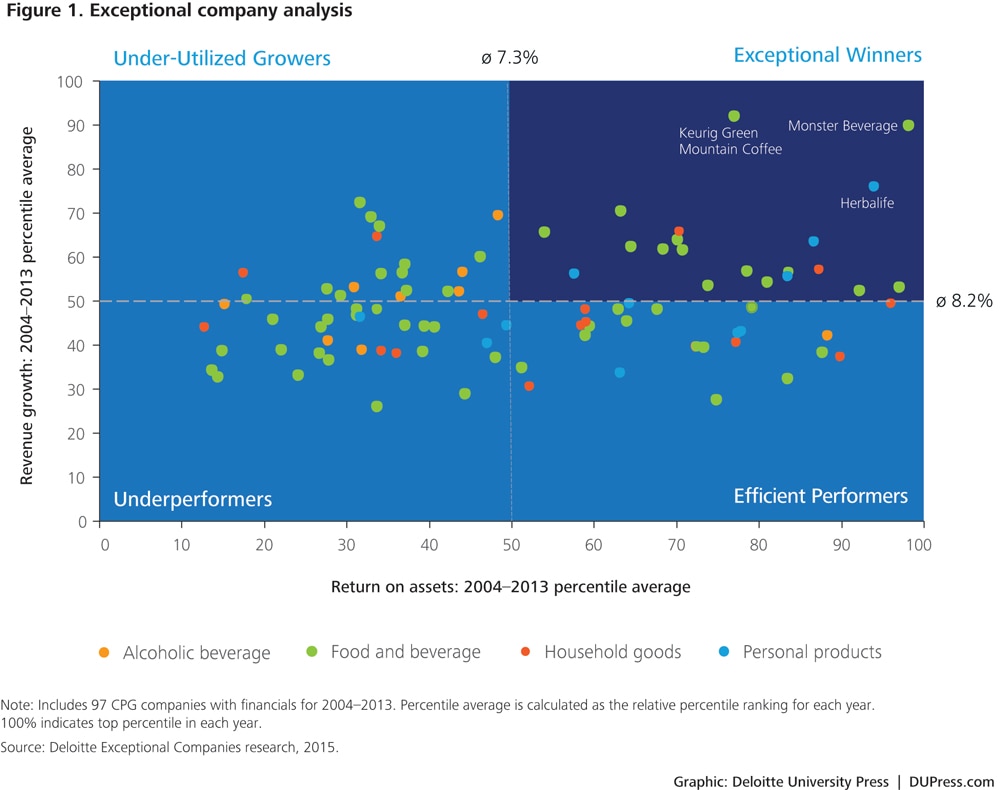
From our analysis, we found exceptional performance can be achieved within different consumer goods industry segments (e.g., personal care products or food and beverage) and across different company sizes. The only exception is the alcoholic beverage sector, in which no Exceptional Winners operate today. This is good news for managers and investors alike, as any company can deliver exceptional performance. But how do you do it?
What do Exceptional Winners do to win in the market?
To understand how Exceptional Winners win in the market, we conducted an extensive executive survey and profiled the business models of the selected 97 companies. We triangulated the results from the executive survey, with an independent analysis of the companies using public annual reports/10-Ks, investor presentations, analyst reports, and press releases. Finally, we completed an internal survey among Deloitte partners and directors working with these consumer goods companies to complete the profiles. We believe this approach has provided us with a solid fact base around the dominant business models in the consumer goods industry.

Through our research and analysis of Exceptional Winners, informed by case studies, executive interviews, and prior research, we have identified four themes that set Exceptional Winners apart from their peers.
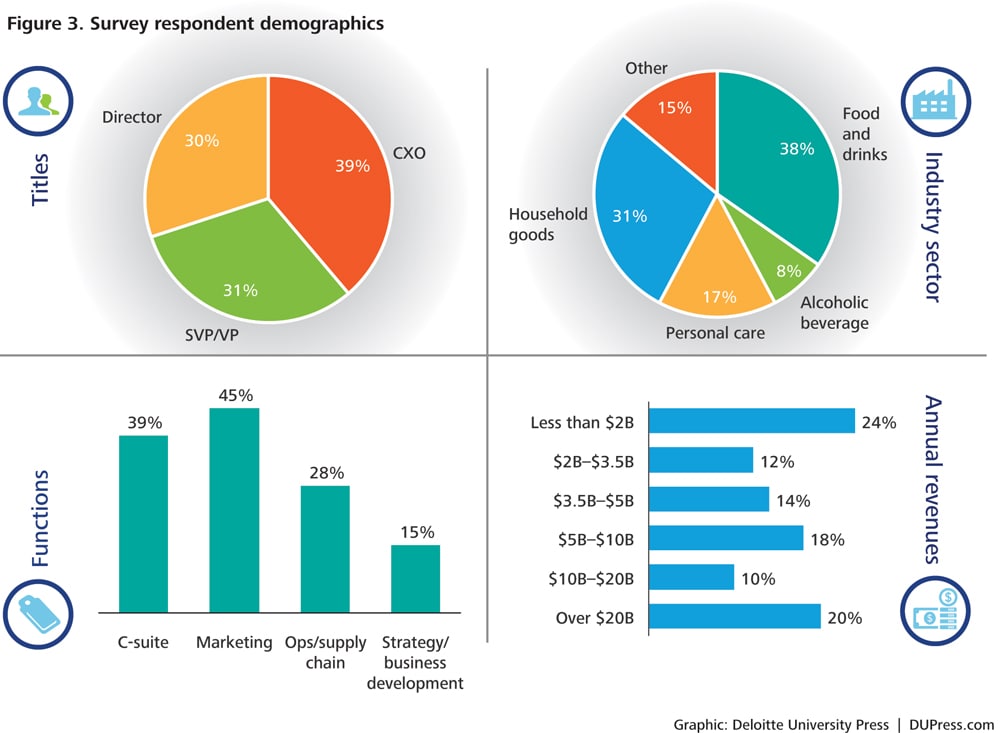
Focus intensely on what they do best by creating a coherent business and operating model
Exceptional Winners figure out what they’re really good at, and configure their business model as well as operating model accordingly. They focus intensely on what they do better than others to win in the market and build truly distinctive capabilities. Successful companies have a clear understanding of how they win in the market and create value, and have developed a clear positioning strategy. However, the bridge between strategy and impact is the business and operating model, and by configuring the business model to create a system of mutually reinforcing capabilities, the competitive advantage can become more powerful.
In our research and analysis, we found that what Exceptional Winners have in common is the adherence to a certain business model (see figure 4). We measured the Business Model Coherence as a function of how closely aligned the company was to a certain business model type. Each company was assessed across 32 factors to determine each business model type. The higher the score for a certain type of business model, to the exclusion of other business models, the higher the overall coherence score. A company with a high Business Model Coherence score (e.g., Monster Beverage) has made conscious choices about using a single business model throughout the entire company, whereas a company with a low coherence score operates multiple business models. This Business Model coherence is positively correlated with greater financial performance. We call this the Business Model Coherence Premium.
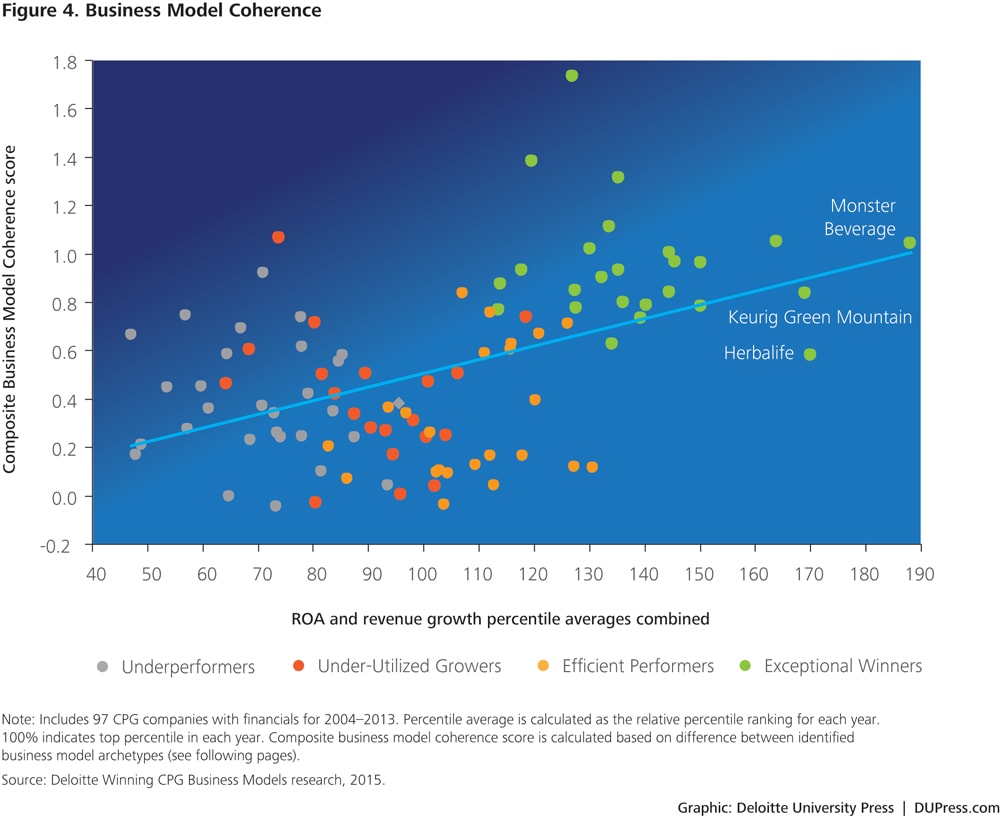
Exceptional Winners, such as Monster Beverage, Herbalife, and Keurig Green Mountain Coffee, all have high Business Model Coherence. As always, there isn’t a single factor (such as Business Model Coherence) that explains all of the difference in a company’s financial performance. However, given the solid correlation (r-squared=0.23), we’re confident that Business Model Coherence is a dominant factor in explaining why some companies perform better than others.
Drive value from one of three dominant business model types in consumer goods
To determine the dominant business model types in consumer goods, we asked survey respondents to score their company across 32 descriptive statements on a 4-point scale. These statements aimed to describe the company’s business model and included descriptions such as “emphasize economies of scale with products” and “tailors the product or service to satisfy specific customer needs within each segment.” Independently, we scored and verified each company using public information to cross-check the company’s business model profiles.
Through our research and analysis, we identified three dominant business model types (see figure 5).

Operational Excellence
Companies with an Operational Excellence business model are capitalizing on proprietary capabilities that lower total value chain cost in a differentiated way. These manufacturers are driven by powerful scale economics, requiring capabilities to manage high volume, routine processing activities, and have cultures that prioritize standardization, cost control, and predictability. The asset trumps the human being.2 This business model configuration is also referred to as Infrastructure Management or Asset Building.
We found large branded companies striving for operational excellence in their business model. That includes running large marketing campaigns to drive volume of large brands. Other consumer goods companies with an Operational Excellence business model include large private label manufacturers and commodity producers.
Within consumer goods, Operational Excellence is the dominant business model, with 31 percent of companies deploying it and a further 17 percent of companies having some kind of hybrid business model with elements of Operational Excellence. More about these hybrid models later.
Product/Brand Leadership
Companies with a Product/Brand Leadership business model focus on very different economics, skill sets, and cultures from the Operational Excellence model. These companies are driven by economies of time—speed to market—and, as a result, require skills focused on rapid innovation and iteration in product development, so that market opportunities can be quickly identified and addressed. The culture prioritizes creative talent—everything is oriented toward supporting the development of strong brands and innovation.3 This business model has also been referred to as Product Innovation and Commercialization or Technology Creators.
In some cases, these companies have developed a propritary technology and formulation. In other cases they have created strong and distinctive capabilities that allow them to initiate change to which competitors must react (see case study on Monster Beverage).
The Product/Brand Leadership business model is the third-largest type within consumer goods, with 17 percent of companies deploying it.
Customer Solutions
The Customer Solutions business model is built around economies of scope—creating broader relationships with a growing number of customers. This business model type requires skills related to gathering and analyzing large amounts of data to develop a much deeper understanding of the evolving context of each customer. The culture of this business model type is completely focused on the customer—the customer is king no matter how much internal turmoil and heartburn meeting customer requirements might create.4 Other names for this type of business model include Service Provider and Customer Relationship.
Within consumer goods, we identified two types of Customer Solutions companies: Direct-selling companies such as Nu Skin Enterprises (see case study), and companies with multiple product categories and business units, but an integrated focus on the customer (the retailer) to deliver tailored solutions.
Customer Solutions is the second-largest business model type in consumer goods, with 28 percent of companies deploying it to deliver their strategies. A further 7 percent of companies use elements of the Customer Solutions business model as part of a hybrid model.
Hybrid business models
As you would anticipate, a number of companies have created hybrid business models, where they focus on several business model elements at the same time. The most prevalent hybrid business model was the mix between Operational Excellence and Product/Brand Leadership (16 percent).
As John Hagel wrote in his widely quoted Harvard Business Review article entitled “Unbundling the corporation,” focusing on multiple business model types at the same time can create internal friction. Let’s just take a couple of examples of how this friction leads to sub-optimization of performance. If a company really wants to build trust with its customers through a Customer Solutions business model, it should be prepared to connect its customers with the best products and services to meet customers’ needs, even if that involves recommending products and services developed by other companies. Yet, if it at the same time is trying to be a Product/Brand Leader, it may want to restrict the choice offered to customers so that it only involves the products and services developed by the company. On the culture front, product developers and marketers have contempt for the supply chain people who try to confine their creativity by seeking standardization and cost savings. Or the salespeople may view back-office operations as an obstacle to effectively serving the unanticipated and unique needs of their retail customers.5 (For more on this subject, please read “Unbundling the corporation” by John Hagel III.)6
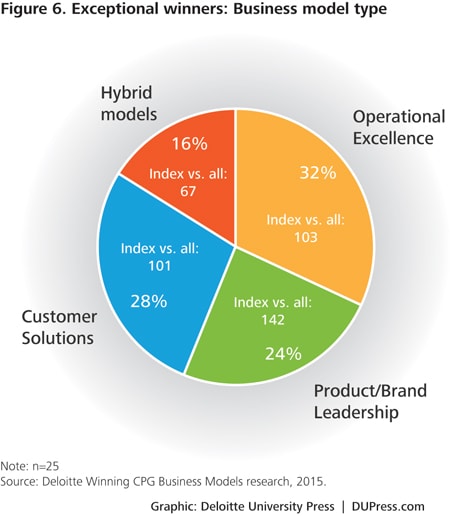 In our research, we did find a small number of Exceptional Winners with a hybrid business model. They have designed their business model by choice, and developed a clear and distinctive set of world-class capabilities. By designing their business model as a self-reinforcing system of distinctive capabilities, these companies have overcome the internal conflict.
In our research, we did find a small number of Exceptional Winners with a hybrid business model. They have designed their business model by choice, and developed a clear and distinctive set of world-class capabilities. By designing their business model as a self-reinforcing system of distinctive capabilities, these companies have overcome the internal conflict.
Among the 25 consumer goods companies classified as Exceptional Winners, the most dominant business model type was Operational Excellence (32 percent), followed by Customer Solutions (28 percent), and Product/Brand Leadership (24 percent). However, the Product/Brand Leadership business model clearly over-indexed for Exceptional Winners versus all companies (24 percent versus 17 percent).
We postulate that the business model type itself is not the determinant factor in exceptional performance, but rather the coherence to the chosen business model. It would appear as though Exceptional Winners have found sustained performance more often than their peers with the Product/Brand Leadership business model.
Monster's relentless focus on Product/Brand Leadership
In a relatively flat soft drinks category,7 Monster Beverage Corporation has managed to grow revenues from $92 million in 2002 to $2.25 billion in 2014, and is today the second-largest energy drink maker in the world. In the last 10 years, Monster Beverage has delivered average annual revenue growth of 34 percent, and an average ROA of 31 percent.8
To deliver this kind of performance, Monster Beverage has focused on a Product/Brand Leadership business model, concentrating on marketing instead of manufacturing and distribution. Production is outsourced to third-party manufacturers, on short duration agreements, while distribution is dealt with by full-service distributors.9
The Product/Brand Leadership model has enabled a portfolio of energy drinks, marketing campaigns, and continued innovation. In 2014, it became a focused energy beverage company through the acquisition of Coca-Cola’s energy drinks, and divestiture of all of its non-energy drinks to Coca-Cola, capturing 44 percent of the US energy drinks market.10 The same year, Forbes magazine voted Monster Beverage as the 15th most innovative company in the world.11
To execute its Product/Brand Leadership business model, Monster Beverage has appointed a chief brand officer, and two-thirds of its over 1,200 full-time employees are in sales and marketing.12
Develop a set of critical and distinctive capabilities that work together as part of a self-reinforcing business model
In a world of mounting performance pressure, most companies cannot afford to sub-optimize their performance as they seek to navigate interminable organizational conflicts. Instead, managers should focus their business model so that they can leverage their agility, flexibility, and ability to learn.13 In our research, we found Exceptional Winners had developed a set of critical and distinctive capabilities in line with their business model design. By creating a self-reinforcing business model based on this set of distinctive capabilities, Exceptional Winners were able to deliver sustainable performance and outperform their peers over time.
Articulating the company’s critical and distinctive capabilities is a vital step in defining a winning business model. Identifying the capabilities required to deliver the where-to-play and how-to-win choices crystallizes the area of focus and investment for the company. As A. G. Lafley and Roger Martin noted in their book Playing to Win: How Strategy Really Works,14 it enables a company to continue to invest in its current capabilities, to build up others, and to reduce the investment in capabilities that are not essential to the business model: "Companies can be good at a lot of things. But there are a smaller number . . . that together create distinctiveness, underpinning specific where-to-play and how-to-win choices. P&G certainly needs to be good at manufacturing, but not distinctively good at it to win. On the other hand, P&G does need to be distinctively good at understanding consumers, at innovation, and at branding its products."15
Nu Skin’s distinctive capabilities
Nu Skin Enterprises is a direct selling company selling anti-aging products under the Nu Skin brand and dietary supplements under the Pharmanex brand. Ninety-one percent of revenue comes from international markets; the company has 1,335,000 “actives” or customers, and 102,000 sales leaders or distributors.16 Nu Skin is an Exceptional Winner in the CG industry, and has in the last 10 years delivered compound annual revenue growth of 14.2 percent, with an ROA of 14.4 percent.17
To deliver its Customer Solutions business model, Nu Skin has developed a set of critical and distinctive capabilities that work together as part of a self-reinforcing system. In particular, it focuses on four leading distinctive capabilities:
Brand management linked through LifeGen Technologies
In 2011, Nu Skin acquired LifeGen Technologies and has used that company’s patents to create a balanced brand portfolio of skin care under the Nu Skin brand, and nutritional and dietary supplements under the Pharmanex brand. The company has over 100 products under the Nu Skin brand, and another 100 products under the Pharmanex brand.18
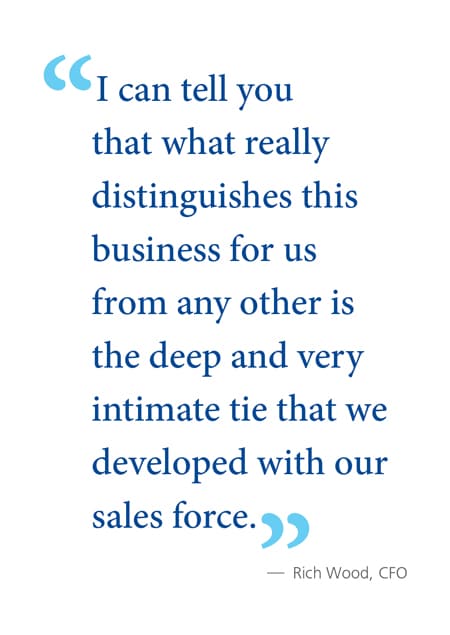
World-class sales management of more than 100,000 sales leaders
Nu Skin views its distributors and sales leaders as one of its biggest assets and invests in them accordingly. That includes providing sales leaders with tools and technology to be efficient, seamless compensation, and education. Its investments in sales management have enabled Nu Skin to reduce its global new product roll-out from three years to less than one year.19
Industry-leading customer service management
Nu Skin is customer relationship-driven, and puts customer service and satisfaction at the forefront. That includes a distribution model that enables its sales force to provide high levels of service and encourage repeat purchases. The company continues to improve its customer services operations, implementing a streamlined technology solution with instant phone number match that provides consolidated customer information, as well as a new agent training system.
New product development around an anti-aging platform
Nu Skin has a targeted focus on anti-aging and offers total customer solutions through skin and supplement products. Its latest innovation, ageLOC© Me, combines skin, supplement, and technology to deliver a precise dose of anti-aging product at the right time. The company has developed relationships with multiple collaborative research partners and established research agreements with key academic institutions, which has allowed it to develop a strong pipeline of new and innovative products.
In our survey of US consumer goods executives, we asked them to rate their enterprise capabilities on two key dimensions: how critical the capability is to the company’s business model and its ability to win in the market; and what the company does uniquely well compared to its competitors, and is known for in the market (distinctiveness).
A full set of 42 enterprise capabilities were included in the research, with each respondent being asked to rate the relevant capabilities to their company on a five-point scoring scale.
From our analysis, we found each business model has a unique set of capabilities and there were few overlaps in terms of critical and distinctive capabilities between the models. This supports the existence of the three distinct business models described above, as each business model type requires a different set of capabilities (see figure 7).
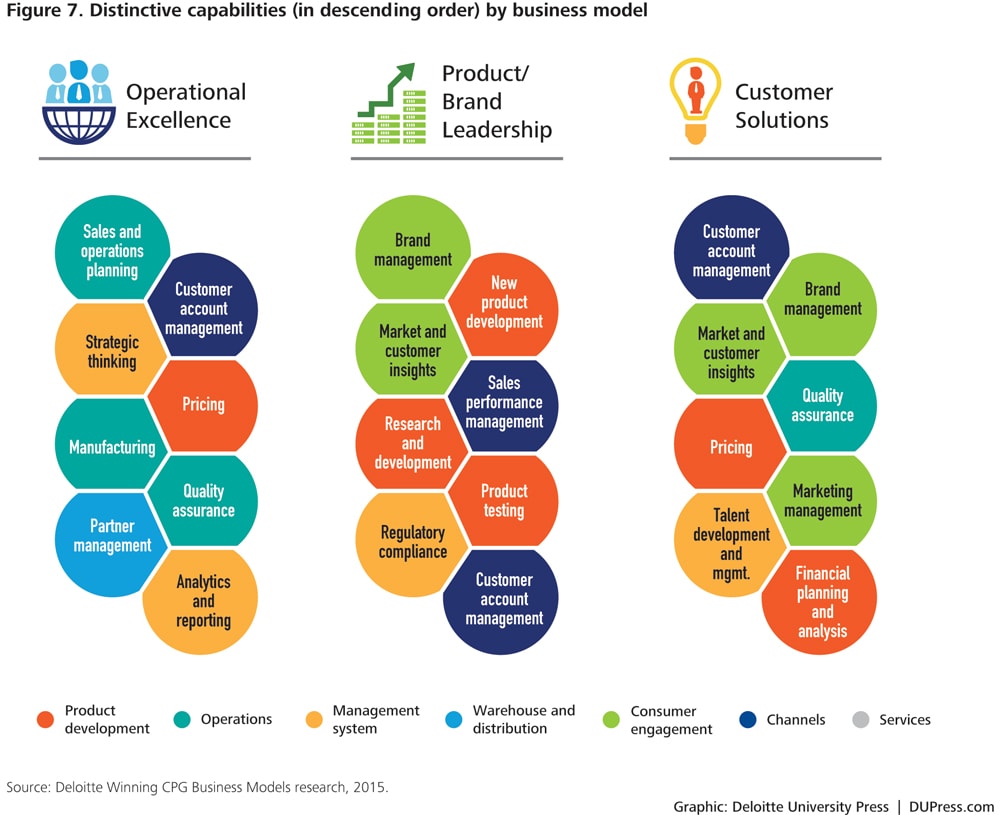
Operational Excellence
Consumer goods companies with an Operational Excellence business model mainly focus on creating distinctiveness in key areas such as operations, warehouse and distribution, and channel management. Respondents rated operations capabilities such as sales and operations planning (S&OP), manufacturing, and quality assurance high, and also scored customer account management and pricing of equal importance. Partner management was also deemed to be critical. To enable these distinctive capabilities, strategic planning and analytics and reporting were also rated high.
Product/Brand Leadership
For companies with a Product/Brand Leadership business model, product development and consumer engagement were important. Respondents found market and customer insights, research and development, product development, and product testing capabilities important to create competitive advantage, as well as brand management, customer account management, and sales performance management. For a number of companies, regulatory compliance—how to work with the FDA to manage claims—was also a distinctive capability.
Customer Solutions
Consumer goods companies with a Customer Solutions business model rated channels and consumer engagement as important areas for their business model. The No. 1 capability was customer account management (this includes sales leaders in a direct selling model). However, market and customer insights, brand management, and marketing management were also rated as distinctive capabilities. Quality assurance, pricing, and financial planning and analysis were also scored high. Given the importance of people in the Customer Solutions business model, it was no surprise that the talent development and management capability was also rated high.
Drive greater maturity into the distinctive capabilities than their peers
As part of our research, we asked the executives to rate the maturity of their critical capabilities. For each capability, we defined what it means to have a lagging, performing, or leading capability and asked the respondents to select the statement that best described the maturity level of each capability. Based on these self-reported maturity levels, we found Exceptional Winners in many cases focused on similar critical and distinctive capabilities as their competitors, but were leading in terms of maturity. For example, for Operational Excellence, Exceptional Winners used manufacturing, quality assurance, partner management, and analytics and reporting to differentiate themselves and had created leading positions (see figure 8).
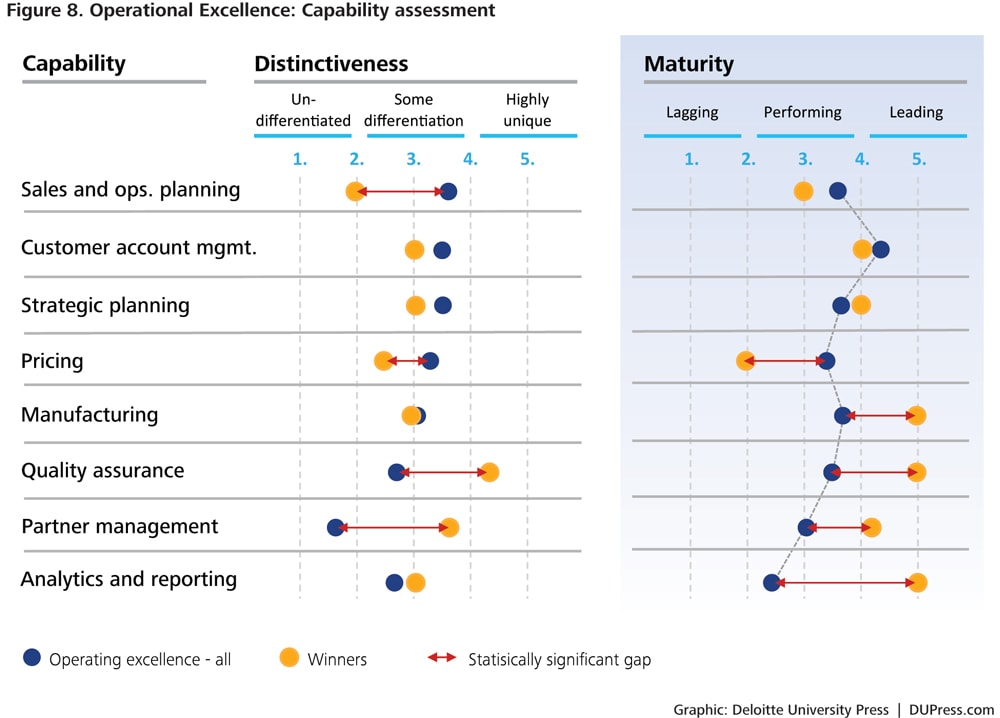
How to create a coherent business model to become an Exceptional Winner
As described above, what sets Exceptional Winners apart from their peers is they have figured out what they’re really good at, and configured their business model as well as their operating model accordingly. They have created a strong, focused, and coherent business model.
A coherent business model makes the most efficient use of a company’s resources, attention, and time. By allocating capital and expenses more deliberately and effectively, companies focus more on the capabilities that create differentiation. Thus far, we have focused on describing the characteristics of Business Model Coherence to answer the question, What does it look like for different business model types? The next obvious question, though, is How do I create a coherent business model?
To unlock the potential benefits of Business Model Coherence, you should consider taking four deliberate steps: reconsider your current business model design; prioritize five to six mutually reinforcing and distinctive capabilities; define what it will take to be world-class in those capabilities and rapidly transform and test; and scale to the entire business.
Design a clear and self-reinforcing business model
The full value of capabilities emerges only when they work together in a mutually reinforcing system linked to viable where-to-play and how-to-win choices.
In their book Playing to Win: How Strategy Really Works, Lafley and Martin described the strategic choices that needed to be made to determine the best configuration of the business model, and the choice of critical and distinctive capabilities. Part of those choices include whether you want to re-configure the business model itself (e.g., focus on a Product/Brand Leadership model), or change the elements of the business model (e.g., go-to-market system or profit model).
Prioritize strategic capabilities
As described by Prahalad and Hamel,20 few companies are likely to build world leadership in more than five or six distinctive capabilities. Start by doing a capabilities inventory to understand what your company is already doing exceptionally well. For the most critical capabilities, estimate the amount of investment that would be required to give your company the distinction it needs. If too many gaps need closing, then ask whether you can really change enough to deliver the capabilities and the business model.
Begin the transformation by rapidly prototyping capabilities
A capability is not simply about people, processes, and technology. It is the ability to reliably and consistently deliver a specified outcome, through the alignment of insights, talent, processes, technology, and governance. Leaders are taking lessons from the startup playbook on “minimum viable products” to launch minimum viable transformations—lightweight and readily adaptable versions of potential new business models.21 We believe more business model transformations are starting their lives as minimum viable transformations versus the “big bang,” more linear and detailed planning approach. De-risked, minimum viable transformations put the focus on the distinctive capabilities of the envisioned business model that involve the highest uncertainties. Through rapid prototyping and testing, you can learn how to create a world-class capability and operating model.
Scale and expand business and operating model
The new envisioned business model is ready to scale when you have found ways to create strategic capabilities that are distinctive, well realized, sophisticated, and backed up by a deep organization commitment.
As you think about how to create a coherent business model to deliver sustained performance, here are some questions to ponder:
- Have you made intentional choices around your business model configuration, and how do these link to your company’s where-to-play and how-to-win positioning?
- Do you know what five to six critical and distinctive capabilities to invest in, how they work together as part of a self-reinforcing business model, and how they differ from the Exceptional Winners?
- Do you understand what it will take to be world-class in those capabilities, what your current level of maturity is, and what kind of investment and transformation is needed?
- How can you best transform your business model while still meeting Wall Street quarterly earnings expectations—“big bang” or a series of minimum viable transformations?




